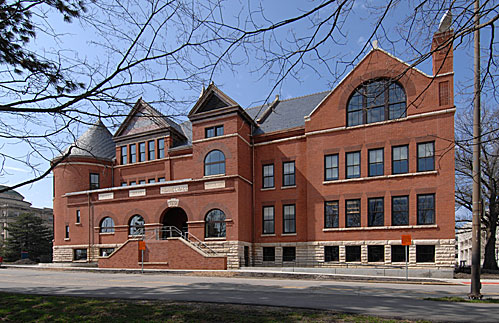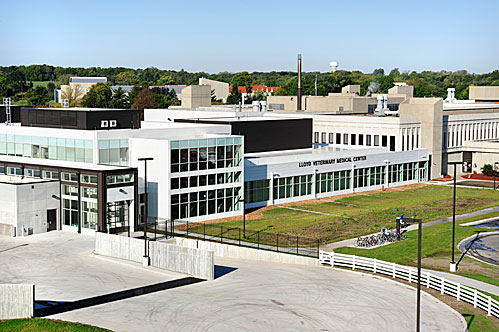Feb. 18, 2010

Morrill Hall and Veterinary Medicine (see below) outdid other buildings on campus in FY09 in reducing energy use. Both facilities used 28 percent less energy than in the previous year, according to recently released FPM figures. File photo.
Top energy savers: Morrill, Vet Med, Parks Library
by Diana Pounds
The numbers are in, and in the spirit of the times, let's just say that Morrill Hall takes the gold, Veterinary Medicine the silver and Parks Library the bronze.
These three buildings have risen to the top in the campus quest for more energy savings. From FY08 to FY09, energy use (electricity, steam and chilled water) went down by just over 28 percent in Morrill, an even 28 percent in Vet Med and 21.5 percent in Parks Library.
Just missing the podium was the Union Drive Community Center (UDCC), with 21.4 percent less energy use in FY09.
Facilities planning and management staff recently compared energy use in 42 campus buildings. (See chart.) More than 60 percent of the facilities used less energy in FY09 than FY08. (Excluded from the study were buildings that weren't fully metered for electricity, steam and chilled water in FY08.) Energy savings can come from big things like renovations or little things like flipping switches.
Here are some of the things that made Morrill, Vet Med, Parks Library and UDCC top energy savers last year.
Morrill Hall
With a LEED silver rating, Morrill is designed to use 10 percent less water and 35 percent less energy for heating and cooling than standard buildings, said FPM project manager Kerry Dixon-Fox. In addition, on a sunny day, nothing more than sunlight is necessary to illuminate more than 82 percent of the occupied spaces in the building.
FY08 was the first year of operation for the newly renovated Morrill. Dixon-Fox says energy savings in FY09 may be a result of first-year tweaks on the new building. Another energy-saving routine adopted by administrative specialist Jane Henning is periodic classroom "walk-throughs" during the day to ensure that unnecessary lights are off.

Veterinary Medicine. Photo by Bob Elbert.
Veterinary Medicine
Program coordinator Brian Adams cites a list of energy-saving improvements that may have cinched the silver for Vet Med. New energy-efficient lighting replaced the old incandescent and fluorescent lights in a classroom, an outdoor plaza and restrooms.
A new electric chiller reduced consumption of electricity and steam, and a new air handler control system provided more precise control of heating and cooling. Unused fume hoods also were deactivated, insulation was added over some lab spaces, and temperatures were set back in unoccupied or lightly used areas.
Parks Library
With the formation of a sustainability task force in early FY09, library staff kicked conservation efforts up a notch. A few months later, the task force had much more to show for its efforts than a report and a 94-item sustainability "to-do" list. Weatherizing film had been installed on first floor windows in the old part of the library. Many library faculty and staff had adopted task force suggestions to turn electronics off, to print only when absolutely necessary, and to share refrigerators, microwaves and coffee pots.
"There was lots of community buy-in," said Sarah Passonneau, assistant to the dean and head of the task force.
FPM staff did their part. Area mechanic Bob Kalvik said FPM staff upgraded many areas of the library with more efficient lighting and windows. They also found ways to refine use of the library air handlers, to provide more efficient heating and cooling.
UDCC
Officials of ISU Dining, which makes up 90 percent of the UDCC, can't point to any big project or activities that would account for the nice energy savings realized in FY09. However, ISU Dining has built up a strong resume of sustainable activities that includes using green products, contributing food waste to ISU's composting program and purchasing local food. This green mindset, program coordinator Brittney Rutherford said, is reflected in general everyday efforts to save by turning off fume hoods, using less water and shutting down computers and other unused electronics.
